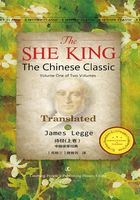
FOW-E
1 We gather and gather the plantains;
Now we may gather them.
We gather and gather the plantains;
Now we have got them.

It is difficult to choose between them. On Choo's view the piece is allusive; on Maou's, narrative.
L.2. 丁 (read chăng) 丁 is intended to represent the sound of the blows (椓) on the pins or pegs (杙) used in setting the nets.
L.3. Both Maou and Choo give 赳赳 as= 'martial-like', while the Shwoh-wăn defines the phrase by 輕勁有財力, 'light, vigorous, able, and strong'. L.4. 公侯= 'duke and marquis'; together,=prince. We are to understand king Wăn by the designation. At the time to which the ode refers, he was not yet styled king,and, indeed, Choo takes the phrase as one proof that Wăn never assumed that title. Maou takes 干=扞, so that 干城 go together,= 'defender', or 'wall of defence';probably after Tso-she, in his narrative appended to the 12th year of duke Ching. 'Shield and wall', however,are suitable enough in the connection.
St.2. L.2. 施 is read she, 'to place', 'to set'. 中逵 and中林 below,—like 中谷 in Ode II. 逵=九逵之道, 'a place from which 9 ways proceed'. I have asked Wang T'aou and other scholars, whether such a thoroughfare was not an unlikely place to catch rabbits in, and got no satisfactory answer. L.4. 仇=逑 in Ode I.
There is a difficulty as to the rhyming of 逵and 仇. The latter is said to be here read, by poetical license, k'e. A better solution is to adopt the reading of首 with 九 at the side, instead of 逵, for which there is some evidence.
St.3. L.4. 腹心= 'confidant and guide'; lit., 'belly and heart'. We do not use 'belly' as the Chinese do.
The rhymes are—in st.1, 罝*, 夫, cat.5.t.1; 丁, 城,cat.11: in 2, 罝, 夫; 逵*, 仇, cat.3 t.1 (this is a doubtful rhyme): in 3, 罝, 夫; 林, 心, cat.7.t.1. The alternate lines all rhymes, which is called 隔句韻.

2 We gather and gather the plantains;
Now we pluck the ears.
We gather and gather the plantains;
Now we rub out the seeds.
3 We gather and gather the plantains;
Now we place the seeds in our skirts.
We gather and gather the plantains;
Now we tuck our skirts under out girdles.


